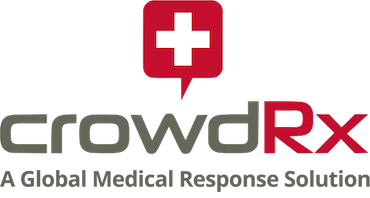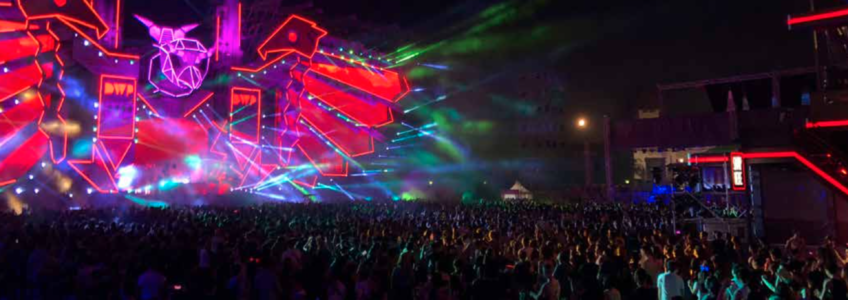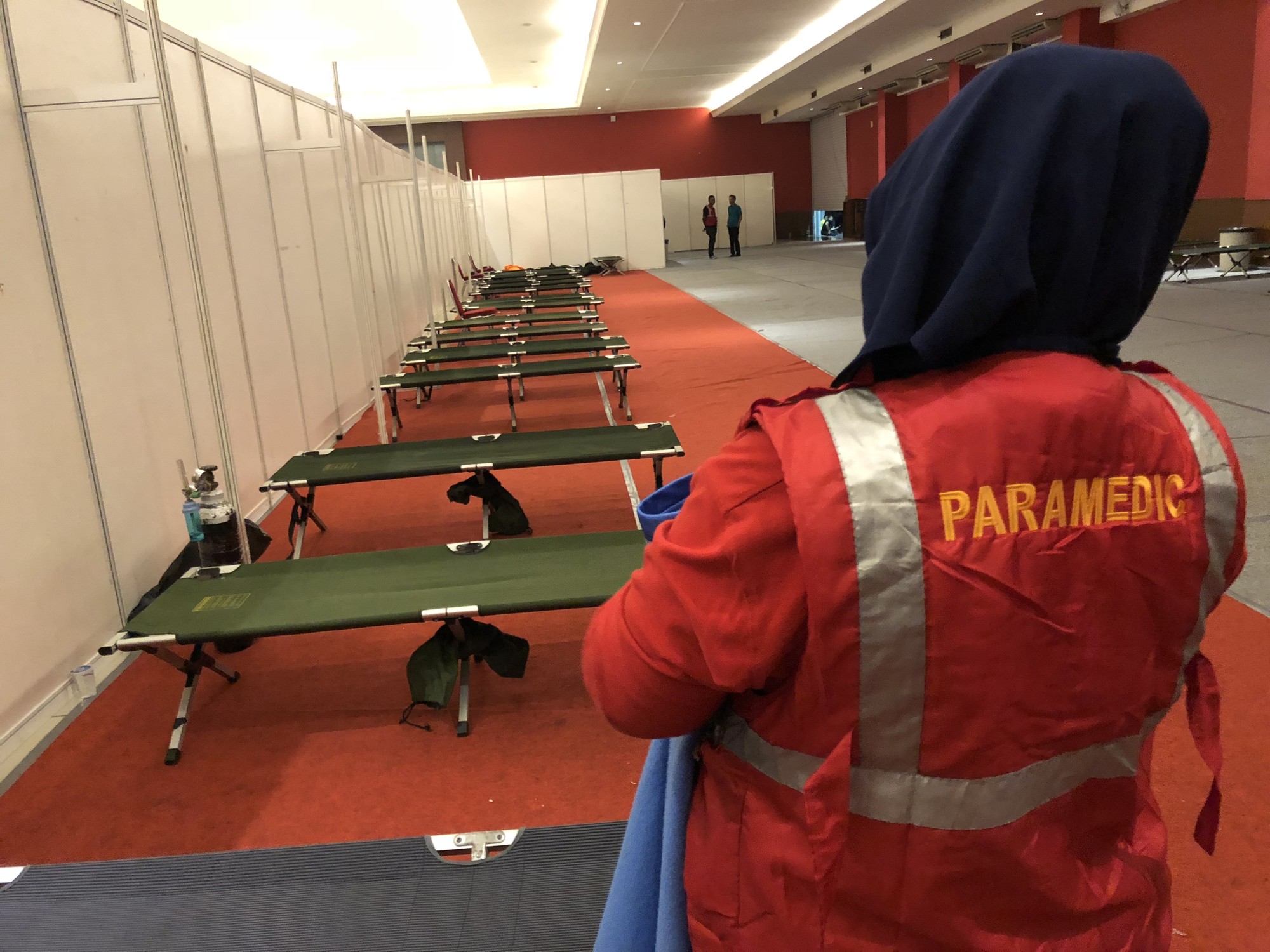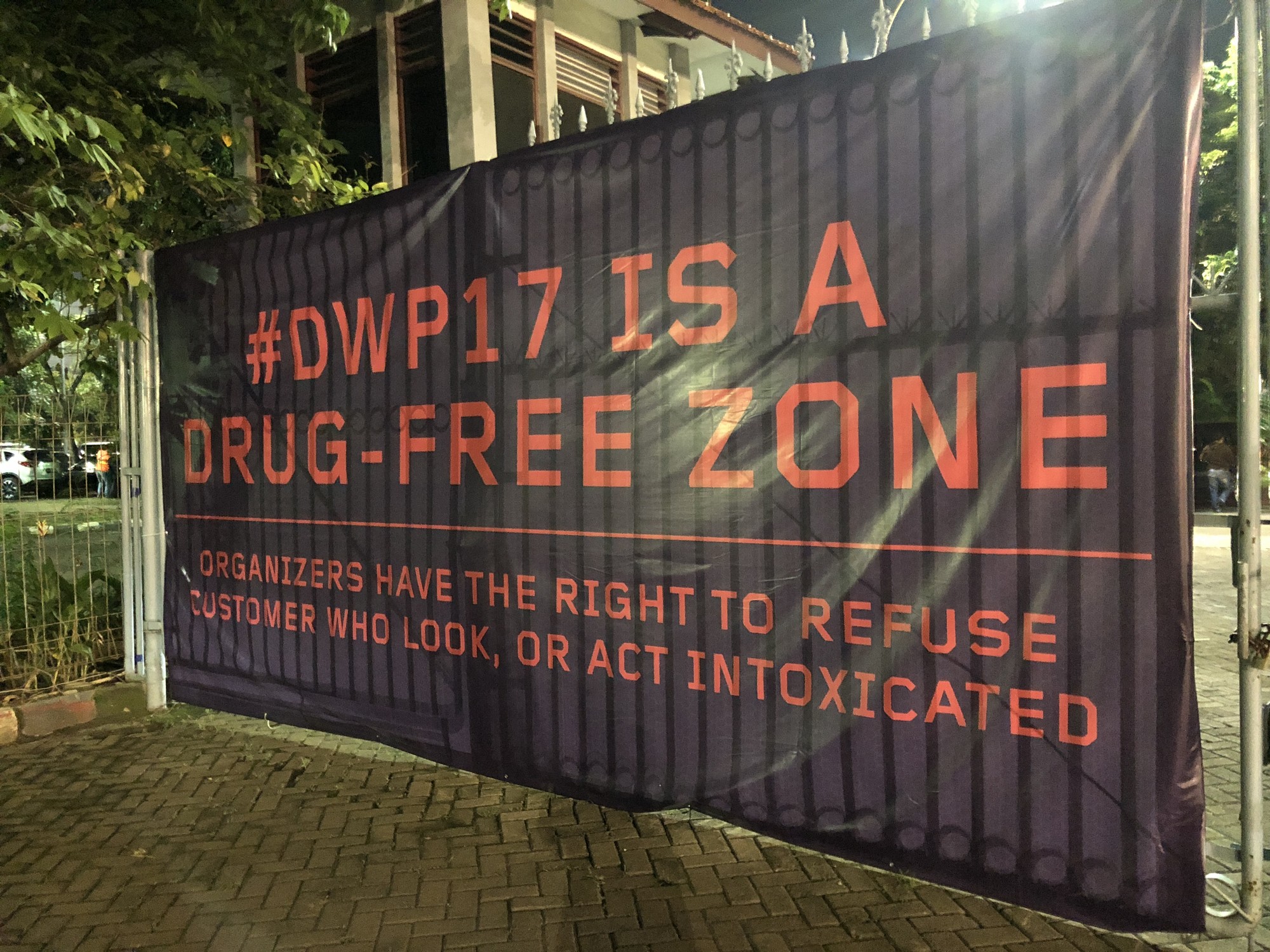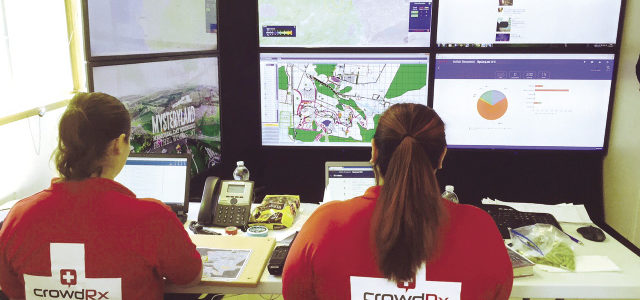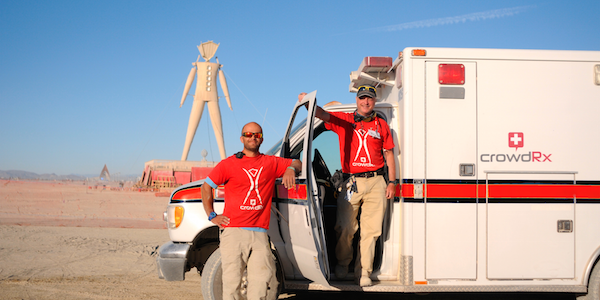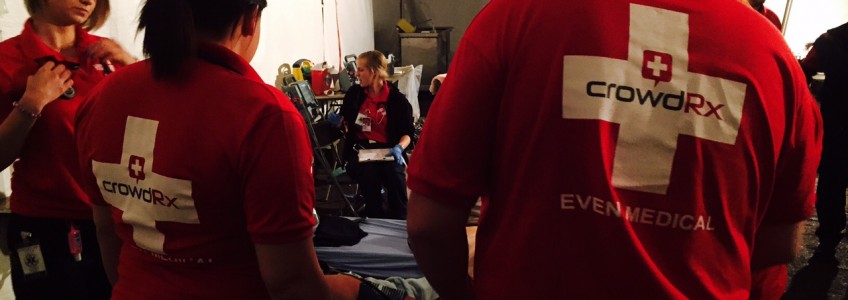Behind the Music: A Look at Medical Care at Asia’s Largest Music Festival
By Alison Leung MD, Connor Fitzpatrick AEMT & Matt Friedman MD
Every December since 2011, Jakarta, Indonesia hosts the largest music festival in Asia and, consequently, one of the largest mass gatherings. Once an underground warehouse rave, the Djakarta Warehouse Project was born out of tragedy. In 2010, a brawl at the original host venue left one dead and two injured two weeks before the event was scheduled. The bar was closed and the founders of the Ismaya Group were forced to find an alternate venue, spurring the birth of the first Djakarta Warehouse Project, better known as the DWP.
Today, the DWP has the largest cumulative attendance of any electronic dance music (EDM) festival in Asia. DWP is a well-organized event with a reported attendance of 90,000 people in 2016, 30 percent of whom were foreign nationals. It is held in an outdoor venue with a hard fence boundary with controlled ingress and egress points which helps with security measures such as limiting weapons, recreational drugs and alcohol.
2017 DWP
The most recent DWP took place in December 2017 over two consecutive days in Jakarta, which is located in the Southeast Asian tropics. Indonesia is the fourth most populous country in the world as well as the most populous Muslim-majority country. Typical ambient temperature is approximately 80 degrees Fahrenheit overnight in Jakarta. Performers ran the gamut across different EDM niches and included well-known names such as Steve Aoki, Hardwell, Flume, Tiesto and Marshmello. It appeared to be a typical music festival that would take place on any other continent, which was surprising considering the purported strict Muslim culture in Jakarta that prohibits alcohol and drug use. For example, under Article 59 of Indonesian Law No. 5 of 1997 on psychotropic drugs, the use, production, possession or trafficking of psychotropic drugs “as an organized crime” is punishable by death. However, the number of death sentences handed down has decreased in recent years.
Right: As the night begins, a Paramedic wearing a hijab stands watch over “Main Medical” which is a fixed structure with adequate lighting, staffing and cots.
According to a Jakarta police spokesperson, 1,000 police officers were deployed to guard the event, which en- counters protesters from right wing religious groups who have deemed it immoral. Additionally, city administration officials dispatched a surveillance team to report on the consumption of drugs and alcohol.
The observed crowd was almost universally engaging in alcohol consumption, at times in excess. Additionally, there seemed to be a large percentage of attendees engaging in illicit recreational drug use. Several attendees confirmed that greater than 50% of their friends who attend these festivals use recreational synthetic “club” drugs. MDMA (Methylenedioxymethamphetamine) and ketamine are the drugs of choice in Indonesia and are relatively easy to purchase on the street. MDMA – “Molly” in crystal or powder form and “Ecstasy” in pill form – is an entactogen, a psychoactive drug that differs from psychedelics or hallucinogens such as LSD and amphetamine or stimulants such as methamphetamine. Entactogens produce euphoria, increased empathy and enhanced sensation and perception, but can also cause agitation, tachycardia, hypertension, seizures, hyper- thermia, and cardiac arrhythmias. While chemically related to both psychedelics and stimulants, MDMA typically differs from psychedelic drugs and stimulants because of its psychological effects like emotional com- munion with others and empathy. Ketamine’s effects include hypnosis, analgesia, hypertension, tachycardia, agitation, hallucinations, anxiety, and psychosis. While the use of recreational ketamine is seen globally, it appears to be more common in East and Southeast Asia because of its relatively low price.
Despite the reported widespread use of recreational drugs, very few attendees had adverse effects that required medical treatment or transport to the hospital. The medical team that keeps DWP attendees safe confirmed that no fatalities have occurred over the last several years and very few attendees require transport to the hospital during these mass gatherings.
Left: Numerous “Anti-Drug” signs appear throughout the festival, which do not appear especially ominous given Indonesia’s strict death penalty for drug traffickers and life imprisonment for possession.
On-Site Medical Care: The New Standard
Generally – and not surprisingly – mass gatherings have a higher incidence of illness and injury than is expected from the general population, likely related to ambient temperature, event type, event duration, crowd mood, crowd density, attendance, average age, and the prevalence of alcohol and drug use. With the increase in music festival related deaths over this past decade, high level and intensive on-site medical care that offers aggressive cooling, paralysis, chemical sedation and on-site monitoring becomes imperative.6
Medical care at DWP was provided by a local Indonesian for-profit event medical company. Approximately 275 patients were evaluated each night at DWP. Fifteen general practitioner physicians and 50 paramedics were staged at five medical tents that varied in size. Of note, a paramedic in Indonesia has the same prehospital skills as an EMT-Basic, although they also function as nurses in the hospitals. Main medical was a large fixed structure with approximately 40 cots ready for use with optimal lighting, climate control, and egress. Medical care largely consisted of BLS care such as wound care, splinting, and administration of over-the-counter medications and oxygen. Physicians on-site treated the more severe alcohol and drug intoxications with B12 and a normal saline intravenous infusion. There was no on- site point of care analysis or advanced diagnostics. If further chemical sedation was required or more advanced therapeutic interventions were necessary, an anesthesiologist would respond from the hospital to the event. Fortunately that has not been necessary in the last several years.
Large signage, set up by event promoters, noting “Medical” at the five tents were well lit and easily identifiable from multiple positions in the venue and the public perception of care was generally positive. Despite the large attendance of young adults who were purportedly engaging heavily in alcohol use and recreational illicit drug use, there were few critical patients. Two critical patients exhibited signs of ‘Excited Delirium’. Such patients are at risk for life-threatening psychostimulant drug-induced toxicity, which occurs secondary to psychostimulant use while performing intense physical activity, such as dancing. Symptoms include hy- perthermia with core body temperature ≥ 40.5°C (105°F) and changes in mental status such as agitation, delusions, hallucinations, seizures, or coma. While these two patients were certainly at risk for this, they were not hyperthermic. For comparison, in a prospective analysis of patients presenting to a large EDM festival in New York, four out of 84 enrolled patients (5%) were hyperthermic. While in the United States, Excited Delirium patients are typically rapidly chemically sedated to prevent further hyperthermia, rhabdomyolysis, ARDS and other end-organ damage, the medical staff at DWP allowed the patients’ friends to attempt to calm or physically restrain them for an extended period of time. One of the two critical patients was trans- ported to the hospital while the other was observed on site.
Emergency Medical Services in Jakarta
In the event transport to a hospital is necessary, DWP relies on the “118 Emergency Ambulance Service” also known as the “Ambulans Gawat Darurat” (AGD) – the only public ambulance service in Indonesia. It is headquartered in Jakarta and is analogous to 911 in the United States, but unlike 911, 118 is not government funded and charges those who can afford to pay. The 118 call center in Jakarta receives about 50 to 75 calls per day, despite a population of more than 10 million. For comparison, in New York City, with a population of 8-12 million depending on the time of day, there are approximately 4,000 911 calls each day. To make matters worse, the AGD is severely underfunded and only owns 43 ambulances with average response times of 37 minutes, compared to ten minutes in the United States and seven minutes in Japan. The poor infrastructure and resources available to respond to medical emergencies make extensive on-site medical care crucial in order for DWP to continue to treat their injured and sick attendees in a timely manner.
Right: An AGD ambulance stands by on-site as average response times have soared to 37 minutes in Jakarta, compared with 10 minutes in the U.S. and 7 minutes in Japan.
Summary
DWP is a well-attended, well-organized music festival that seemed to be similar in size and scope to the various music festivals that occur annually within the United States. There were many young adults having fun, dancing and engaging in both excessive alcohol use and other illicit recre- ational drugs. At DWP, ketamine and MDMA were the drugs of choice. The medical care offered at DWP, despite having adequate light, room and staffing, seemed to offer less intensive and aggressive care than is offered at United States music festivals.
_________________________
Alison Leung MD is a second year emergency medicine resident at Maimonides Medical Center.
Connor B. Fitzpatrick is the Chief Operating Officer of CrowdRx. He is an Incident Response to Terrorist Bombings Instructor, a Tactical EMT, and a Connecticut POSTC Police Instructor. Full Bio
Matt Friedman MD is the Associate Medical Director of Prehospital Care at Maimonides Medical Center and the Lead House Physician at Yankee Stadium, Madison Square Garden and the US Open. Dr. Friedman is the academic co-director of the Mass Gathering Medicine Summit. Full Bio
REFERENCES ONLINE AT EPMONTHLY.COM – Click here to read more!
EP Monthly: The Party Drugs of Summer 2017
By NATHANAEL MARSAN, MD and MATT S. FRIEDMAN, MD
The year’s major festivals have seen a surge in dangerous MDMA overdoses and a return to LSD.
An unresponsive patient rolls in with the local volunteer EMS squad from a nearby music festival after a witnessed generalized tonic-clonic seizure lasting for approximately two minutes with a postictal period. He is tachycardic, warm to the touch, and has dilated, reactive pupils. His friends report he has no known medical problems and has taken eight tabs of ‘acid’ throughout the day. He is slowly returning to his baseline mental status as per his friends. What workup is necessary for this first time seizure and for how long should the patient be monitored?
This decade has brought a notable increase in music festival related deaths. The rising mortality rate may be attributed to increasing popularity of recreational ‘club drugs’; potentially impure compounds composed of cheaper, easier to obtain, synthetic substances with narrower therapeutic indexes and wider toxic windows. Resource management and medical care at certain mass gatherings have responded to the changing needs; advanced, intensive, on-site medical therapies and monitoring are becoming common place to offer emergent treatment promptly and to avoid overburdening local healthcare resources.
Mass gathering medicine (MGM) is a young and rapidly evolving medical discipline that integrates aspects of emergency medicine, disaster medicine, and public health. The standard of care is shifting from first aid coverage to more comprehensive, multidisciplinary medical teams on-site. To mitigate increasing morbidity and mortality, on-site medical staff often includes paramedics, nurses, physicians, and other staff such as drug awareness and sexual assault counselors. On-site medical teams offer similar capabilities and medications as those available in the emergency department
Read the full article in EP Monthly here!
Does Your Event Need a Field Hospital?
Physician-led medical services can be critical at certain types of events.
By Mitra Sorrells
The South by Southwest Music Festival kicks off March 13, while Miami Music Week gets underway March 21. Both mark the unofficial start to “festival season,” when cities around the country host huge multiday gatherings of fans spanning a variety of music genres, from electronic dance music to country and rock. These events, which often involve the dicey combination of high heat and controlled substances such as alcohol and drugs, require special attention to issues of health and safety.
The level of medical services at events can range from a first-aid center staffed by E.M.T.s to a full field hospital with doctors and advanced equipment. Experts suggest planners consider a variety of factors when determining their event’s needs, such as the proximity to a hospital, number and age of attendees, physical characteristics of the site, type of event, and typical medical issues at similar events.
“The producer has to have the philosophy of hosting a party and these are your house guests,” says Dr. Andrew Bazos, chairman of CrowdRx, a company that has provided medical services for events such as Burning Man, Electric Zoo, Mysteryland, the U.S. Open, and more. “A lot of planners may call an ambulance company, but they’re not going to think it through from a protocol playbook. Spending money on three ambulances is not always the right thing. You can get one ambulance and spend the other money on two or three higher-level providers, based on the situation.”
Bazos says a field hospital is often the best choice for events where there are high temperatures, physical activity such as dancing, and the possibility of drug use. “No matter how close the hospital is in that setting, you want to create an emergency room on site. Minutes mean life or death,” he says. A mobile hospital at an event can include a digital x-ray machine, lab equipment to do blood work on site, an ultrasound, and surgeons on call. Bazos says for large multiday events this type of setup equips staff to also treat less urgent medical needs on site rather than creating a burden for local hospitals.
He recommends planners keep detailed records of medical services provided at their events to help them determine the appropriate strategy for future events. Read more here!
Eagle Pharmaceutical Inc.’s Treatment Approved for Malignant Hyperthermia is Being Studied for Intoxication of Psychostimulant Drugs by CrowdRx, Inc.
Intoxication produced by certain illicit stimulant drugs may lead to a life-threatening condition in which the person experiences severe increase in body temperature, metabolic abnormalities, rapid heart rate, aggressiveness, delusions, convulsions, coma or even death.
Eagle Pharmaceuticals is conducting a clinical study to investigate the use of Ryanodex (dantrolene sodium) for the treatment of the acute toxicity induced by illicit psychostimulant drugs, such as MDMA (“Ecstasy”), methamphetamine or MDMC (“Molly”).
Ryanodex is currently approved for the treatment of malignant hyperthermia, a rare life-threatening condition secondary to the use of certain anesthetics and muscle relaxants. Malignant hyperthermia shares some of the same signs and symptoms observed in patients with acute intoxication by psychostimulant drugs.
These illicit psychostimulant drugs are commonly taken at large mass gathering events such as outdoor electronic music festivals.
CrowdRx, a New York based corporation, will implement Eagle’s clinical study at selected summer music festivals, to evaluate the safety and efficacy of Ryanodex for the treatment of psychostimulant drug-induced toxicity.
The current standard treatment of this serious condition is limited to cooling with ice and water and other supportive measures. Patients in the study may receive Ryanodex in addition to the standard treatment, or standard treatment only.
More details about this clinical study can be found at: https://jobs.crowdrx.org/egl-4104-c-1702/
About CrowdRx, Inc.
CrowdRx, Inc., is a New York based medical services company focused on providing health services at mass gathering events, specifically major music festivals, sporting venues, and entertainment arenas. Led by Dr. Andrew Bazos, an orthopedic surgeon specializing in sports medicine, the CrowdRx team of emergency physicians and public safety experts prescribe and deliver medical services for large gatherings nationwide. Additional information is available at jobs.crowdrx.org.
About Eagle Pharmaceutical’s Inc.
Eagle is a specialty pharmaceutical company focused on developing injectable products, primarily in the areas of critical care, orphan diseases, and oncology. Additional information about Eagle Pharmaceuticals Inc. and its products may be found at www.eagleus.com.
NFPA Festival Medicine: Life of the Party
Safe spaces, mental health services, drug checking facilities. Welcome to the brave new world of harm reduction, the latest life safety tool of the booming global festival industry.
BY JESSE ROMAN
It wasn’t always that way, according to Andrew Bazos, a surgeon who started working at large music festivals in New York City in the early 1990s. Back then, promoters were obsessed with lineups, sound production, and security—medical concerns were often an afterthought, he said. “In those days the promoter would call up a local ambulance company and arbitrarily ask amateurs to come by, find a tent near the stage, and bring whatever supplies they deemed appropriate. It didn’t go much further than that,” he said.
Bazos is now the chairman of CrowdRx, one of the industry’s largest event medical providers. Last year, CrowdRx handled medical services for dozens of eclectic events, including Burning Man, the US Open, The Gorge Amphitheatre, Madison Square Garden, and several EDM festivals including Mysteryland and Electric Zoo. Each event presents a host of unique challenges and considerations, Bazos said, and medical planning goes well beyond grabbing a roll of gauze and hitting the road. “Data now drives everything we do,” he said. “We’re using data to both predict the volume and types of incidents we’ll see so we can be prepared on the supply side. At this point we can identify what the transport rate [to the hospital] will likely be based on four or five different key data points.” Variables such as music genre, whether camping is allowed, whether alcohol will be sold, the expected number and demographics of attendees, geographic location, and proximity to hospitals can all greatly alter the supplies, equipment, and staffing required for an event, Bazos said.
Prefestival stakeholder meetings are held to review logistics and response plans, which often include tabletop exercises. Cooperation and open lines of communication are critical before and during an event, said Connor Fitzpatrick, director of operations at CrowdRx. “Nothing is done in a vacuum, and everything is interdisciplinary,” he said. “Fire, medical, security, operations—all the stakeholders have to be involved because everything affects everything else. If the promoter is charging $10 for water, for instance, that will impact medical concerns.” Click here to read more.
Mass-Gathering Medicine with CrowdRx
By Joe Reinhartz
Pollstar featured the medical team CrowdRx approximately a year ago. Recently, we were offered the opportunity to visit the team onsite at Burning Man. Why not?
At Burning Man, CrowdRx had dedicated pilots to transport patients to Reno if needed, but it also had a healthcare system complete with emergency physicians, nurses, paramedics, X-Ray facilities, ultrasound, a medical laboratory, a pharmacy, and its own fleet of ambulances roaming the playa. The medical treatment and associated costs were paid for by Burning Man and included with the cost of the ticket. CrowdRx also touted that it was able to obtain for the first time in the event’s history a Nevada license for the facility and medical laboratory, “passing criteria to be officially recognized as an Independent Center for Emergency Care.”
The emergency care center was dubbed “Rampart” in honor of the TV show “Emergency!” but we didn’t see anybody yelling into Motorola radios. It was a pretty chill place, with visitors who were appreciative, talkative and whose needs were as routine as a stitch on a pinky finger to as severe as putting a femur in traction after a skydiving accident.
Click here to read the full article!
Rolling Stone Discusses Music Festival Safety
Harm reduction groups are trying to prevent bad trips and medical emergencies – but will the law let them?
To reduce the potential harms of hyperthermia, Bazos says, on-site doctors administer cooling techniques found in hospital settings, which reduces the use of ambulances – a cost-saving and face-saving technique, given that, as he notes, local towns are unlikely to want their ERs overrun with festival-goers. “A lot of festivals are in rural locations and hospitals aren’t equipped by high volume,” he says. “Quicker care on site is much better for many conditions.”
The Metamorphosis of On-Site Medical Care
When you think about the glitz and glamour of any event or festival — regardless of whether it’s large or small —it is a safe bet that on-site emergency medical services wouldn’t be what pops into your mind first. Or even second. But providing the best possible medical care to those attending such festivities has become the life’s work of Dr. Andrew Bazos, Founder and Chairman of Philadelphia, PA-based CrowdRx.
“We want to continue to be the go-to name in on-site medical coverage in the future as we are now and grow even stronger. We want to continue to accumulate data and positive experiences across different venues and different festivals and have our policies and procedures refined so we can share them across the industry so that we can make safe experiences everywhere, whether we are directly involved or not,” Dr. Bazos said. “We are not a company that wants to have a secret formula. In medicine, we try to share good things that we discover with our colleagues. So, even if it means doing consulting at venues to help them make their area better, a safe show elsewhere helps the entire industry, which is what we want to see.”
See the article in LineupLive Magazine here!

